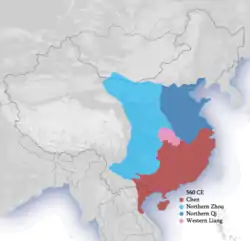Northern Zhou
The Northern Zhou (/dʒoʊ/;[4] Chinese: 北周; pinyin: Bĕi Zhōu) followed the Western Wei, and ruled northern China from 557 to 581 AD. The last of the Northern Dynasties of China's Northern and Southern dynasties period, it was eventually overthrown by the Sui Dynasty. Like the preceding Western and Northern Wei dynasties, the Northern Zhou emperors were of Xianbei descent.
Zhou 周 | |||||||||||
|---|---|---|---|---|---|---|---|---|---|---|---|
| 557–581 | |||||||||||
 Northern Zhou territories in light blue | |||||||||||
 Administrative divisions as of 572 | |||||||||||
| Capital | Chang'an | ||||||||||
| Government | Monarchy | ||||||||||
| Emperor | |||||||||||
• 557 | Emperor Xiaomin of Northern Zhou | ||||||||||
• 557–560 | Emperor Ming of Northern Zhou | ||||||||||
• 560–578 | Emperor Wu of Northern Zhou | ||||||||||
• 578–579 | Emperor Xuan of Northern Zhou | ||||||||||
• 579–581 | Emperor Jing of Northern Zhou | ||||||||||
| History | |||||||||||
• Established | 15 February[1] 557 | ||||||||||
• Disestablished | 4 March[2] 581 | ||||||||||
| Area | |||||||||||
| 577[3] | 1,500,000 km2 (580,000 sq mi) | ||||||||||
| Currency | Chinese coin, Chinese cash | ||||||||||
| |||||||||||
| Today part of | China Mongolia | ||||||||||

History
The Northern Zhou's basis of power was established by Yuwen Tai, who was paramount general of Western Wei, following the split of Northern Wei into Western Wei and Eastern Wei in 535. After Yuwen Tai's death in 556, Yuwen Tai's nephew Yuwen Hu forced Emperor Gong of Western Wei to yield the throne to Yuwen Tai's son Yuwen Jue (Emperor Xiaomin), establishing Northern Zhou. The reigns of the first three emperors (Yuwen Tai's sons) – Emperor Xiaomin, Emperor Ming, and Emperor Wu were dominated by Yuwen Hu, until Emperor Wu ambushed and killed Yuwen Hu in 572 and assumed power personally. With Emperor Wu as a capable ruler, Northern Zhou destroyed rival Northern Qi in 577, taking over Northern Qi's territory. However, Emperor Wu's death in 578 doomed the state, as his son Emperor Xuan was an arbitrary and violent ruler whose unorthodox behavior greatly weakened the state. After his death in 580, when he was already nominally retired (Taishang Huang), Xuan's father-in-law Yang Jian took power, and in 581 seized the throne from Emperor Xuan's son Emperor Jing, establishing Sui. The young Emperor Jing and the imperial Yuwen clan, were subsequently slaughtered by Yang Jian.[5][6]
The area was known as Guannei 關內. The Northern Zhou drew upon the Zhou dynasty for inspiration.[7] The Northern Zhou military included Han Chinese.[8]
Emperors
| Posthumous name | Personal name | Period of Reigns | Era name |
|---|---|---|---|
| Xiaomin | Yuwen Jue | 557 | – |
| Ming, Xiaoming | Yuwen Yu | 557-560 | Wucheng (武成) 559-560 |
| Wu | Yuwen Yong | 561-578 | Baoding (保定) 560-565 Tianhe (天和) 566-572 Jiande (建德) 572-578 Xuanzheng (宣政) 578 |
| Xuan | Yuwen Yun | 578-579 | Dacheng (大成) 579 |
| Jing | Yuwen Chan | 579-581[note 1] | Daxiang (大象) 579-581 Dading (大定) 581 |
Emperors' family tree
| Northern Zhou emperors family tree | |||||||||||||||||||||||||||||||||||||||||||||||||||||||||||||||||||||||||||||||||||||||||||||||||||||||||||||||||||||||||||||||||||||||||||||||||||||||||||||||||||||||||||||||||||||||||||||||||||||||||||||||||||||||||||||||||||||||||||||||||||||||||||||||||||||||||||||||||||||||||||||||||||||||||||||||||||||||||||||||||||||||||||||||||||||||||||||||||||||||||||||||||||||||||||||||||||||||||||||||||||||||||||||||||||||||||||||||||||||||||||||||||||||||||||||||||||||||||||||||||||||||||||||||||||||||||||||||||||||||||||||||||||||||||||||||||||||||||||||||||||||||||||||||||||||||||||||||||||||||||||||||||||||||||||||||||||||||||||||||||||||||||||||||||||||||||||||||||||||||||||||||||||||||||||||||||||||||||||||||||||||||||||||||||||||||||||||||||||||||||||||||||||||||||||||||||||||||||||||||||||||||||
|---|---|---|---|---|---|---|---|---|---|---|---|---|---|---|---|---|---|---|---|---|---|---|---|---|---|---|---|---|---|---|---|---|---|---|---|---|---|---|---|---|---|---|---|---|---|---|---|---|---|---|---|---|---|---|---|---|---|---|---|---|---|---|---|---|---|---|---|---|---|---|---|---|---|---|---|---|---|---|---|---|---|---|---|---|---|---|---|---|---|---|---|---|---|---|---|---|---|---|---|---|---|---|---|---|---|---|---|---|---|---|---|---|---|---|---|---|---|---|---|---|---|---|---|---|---|---|---|---|---|---|---|---|---|---|---|---|---|---|---|---|---|---|---|---|---|---|---|---|---|---|---|---|---|---|---|---|---|---|---|---|---|---|---|---|---|---|---|---|---|---|---|---|---|---|---|---|---|---|---|---|---|---|---|---|---|---|---|---|---|---|---|---|---|---|---|---|---|---|---|---|---|---|---|---|---|---|---|---|---|---|---|---|---|---|---|---|---|---|---|---|---|---|---|---|---|---|---|---|---|---|---|---|---|---|---|---|---|---|---|---|---|---|---|---|---|---|---|---|---|---|---|---|---|---|---|---|---|---|---|---|---|---|---|---|---|---|---|---|---|---|---|---|---|---|---|---|---|---|---|---|---|---|---|---|---|---|---|---|---|---|---|---|---|---|---|---|---|---|---|---|---|---|---|---|---|---|---|---|---|---|---|---|---|---|---|---|---|---|---|---|---|---|---|---|---|---|---|---|---|---|---|---|---|---|---|---|---|---|---|---|---|---|---|---|---|---|---|---|---|---|---|---|---|---|---|---|---|---|---|---|---|---|---|---|---|---|---|---|---|---|---|---|---|---|---|---|---|---|---|---|---|---|---|---|---|---|---|---|---|---|---|---|---|---|---|---|---|---|---|---|---|---|---|---|---|---|---|---|---|---|---|---|---|---|---|---|---|---|---|---|---|---|---|---|---|---|---|---|---|---|---|---|---|---|---|---|---|---|---|---|---|---|---|---|---|---|---|---|---|---|---|---|---|---|---|---|---|---|---|---|---|---|---|---|---|---|---|---|---|---|---|---|---|---|---|---|---|---|---|---|---|---|---|---|---|---|---|---|---|---|---|---|---|---|---|---|---|---|---|---|---|---|---|---|---|---|---|---|---|---|---|---|---|---|---|---|---|---|---|---|---|---|---|---|---|---|---|---|---|---|---|---|---|---|---|---|---|---|---|---|---|---|---|---|---|---|---|---|---|---|---|---|---|---|---|---|---|---|---|---|---|---|---|---|---|---|---|---|---|---|---|---|---|---|---|---|---|---|---|---|---|---|---|---|---|---|---|---|---|---|---|---|---|---|---|---|---|---|---|---|---|---|---|---|---|---|---|---|---|---|---|---|---|---|---|---|---|---|---|---|---|---|---|---|---|---|---|---|---|---|---|---|---|---|---|---|---|---|---|---|---|---|---|---|---|---|---|---|---|---|---|---|---|---|---|---|---|---|---|---|---|---|---|---|---|---|---|---|---|---|---|---|---|---|---|---|---|---|---|---|---|---|---|---|---|---|---|---|---|---|---|---|---|---|---|---|---|---|---|---|---|---|---|---|---|---|---|---|---|---|---|---|---|---|---|---|---|---|---|---|---|---|---|---|---|---|---|---|---|---|---|---|---|---|---|---|---|---|---|---|---|---|---|---|---|---|---|---|---|---|---|---|---|---|---|---|---|---|---|---|---|---|---|---|---|---|---|---|---|---|---|---|---|---|---|---|---|---|---|---|---|---|---|---|---|---|---|---|---|---|---|---|---|---|---|---|---|---|---|---|---|---|---|---|---|---|---|---|---|
| |||||||||||||||||||||||||||||||||||||||||||||||||||||||||||||||||||||||||||||||||||||||||||||||||||||||||||||||||||||||||||||||||||||||||||||||||||||||||||||||||||||||||||||||||||||||||||||||||||||||||||||||||||||||||||||||||||||||||||||||||||||||||||||||||||||||||||||||||||||||||||||||||||||||||||||||||||||||||||||||||||||||||||||||||||||||||||||||||||||||||||||||||||||||||||||||||||||||||||||||||||||||||||||||||||||||||||||||||||||||||||||||||||||||||||||||||||||||||||||||||||||||||||||||||||||||||||||||||||||||||||||||||||||||||||||||||||||||||||||||||||||||||||||||||||||||||||||||||||||||||||||||||||||||||||||||||||||||||||||||||||||||||||||||||||||||||||||||||||||||||||||||||||||||||||||||||||||||||||||||||||||||||||||||||||||||||||||||||||||||||||||||||||||||||||||||||||||||||||||||||||||||||
See also
Notes
- In 580, after Emperor Xuan's death, the general Yuchi Jiong, believing that the regent Yang Jian was about to seize the throne, rose against Yang and declared a son of Emperor Wu's brother Yuwen Zhao (宇文招) the Prince of Zhao, whose name is lost to history, emperor, but as Yuchi was soon defeated, and nothing further was known about the emperor that he declared, that son of Yuwen Zhao is usually not considered an emperor of Northern Zhou.
References
Citations
- Zizhi Tongjian, vol. 167.
- Zizhi Tongjian, vol. 175.
- Rein Taagepera "Size and Duration of Empires: Growth-Decline Curves, 600 B.C. to 600 A.D.", Social Science History Vol. 3, 115-138 (1979)
- "Zhou". Random House Webster's Unabridged Dictionary.
- Patricia Buckley Ebrey; Anne Walthall (1 January 2013). East Asia: A Cultural, Social, and Political History. Cengage Learning. pp. 76–. ISBN 978-1-133-60647-5.
- Patricia Buckley Ebrey; Anne Walthall (1 January 2013). Pre-Modern East Asia: A Cultural, Social, and Political History, Volume I: To 1800. Cengage Learning. pp. 76–. ISBN 978-1-133-60651-2.
- Charles Holcombe (2011). A History of East Asia: From the Origins of Civilization to the Twenty-First Century. Cambridge University Press. pp. 97–. ISBN 978-0-521-51595-5.
- ARS ORIENTALIS. 1986. p. 42.
Sources
- Book of Zhou
- History of Northern Dynasties
- Zizhi Tongjian
External links
 Media related to Northern Zhou Dynasty at Wikimedia Commons
Media related to Northern Zhou Dynasty at Wikimedia Commons